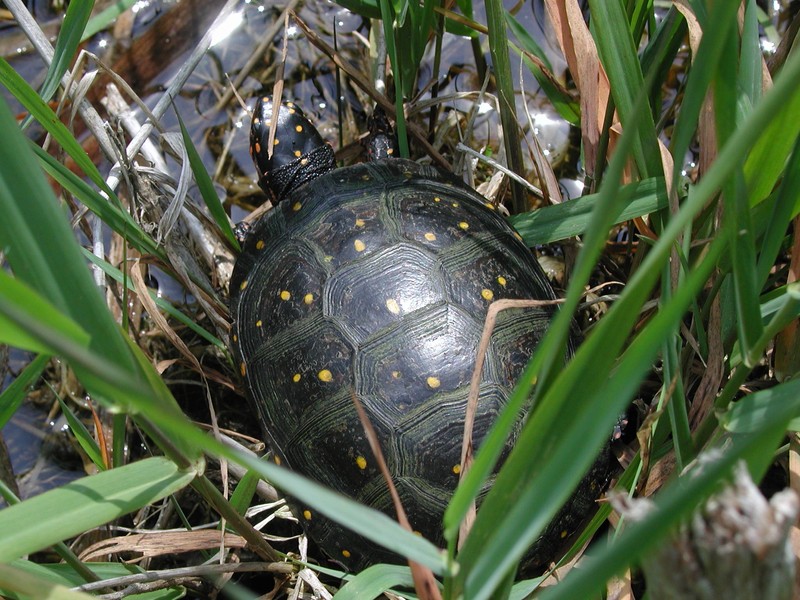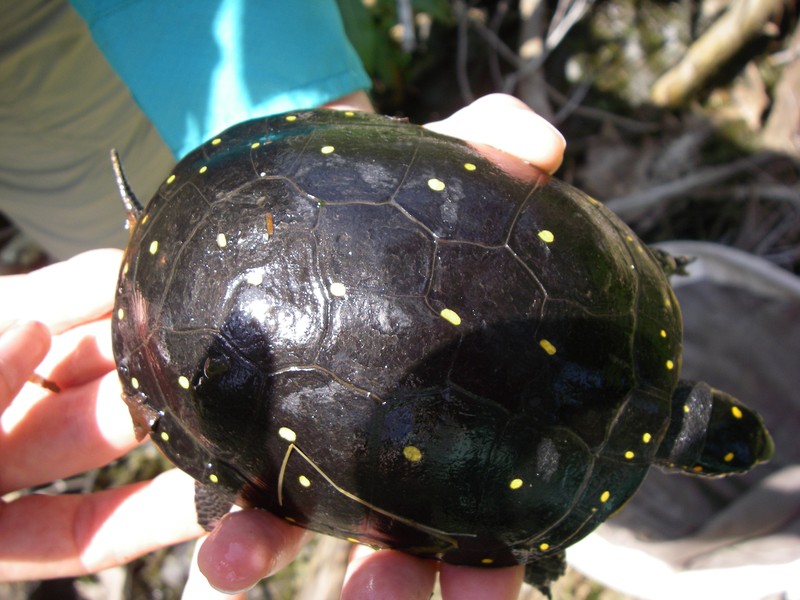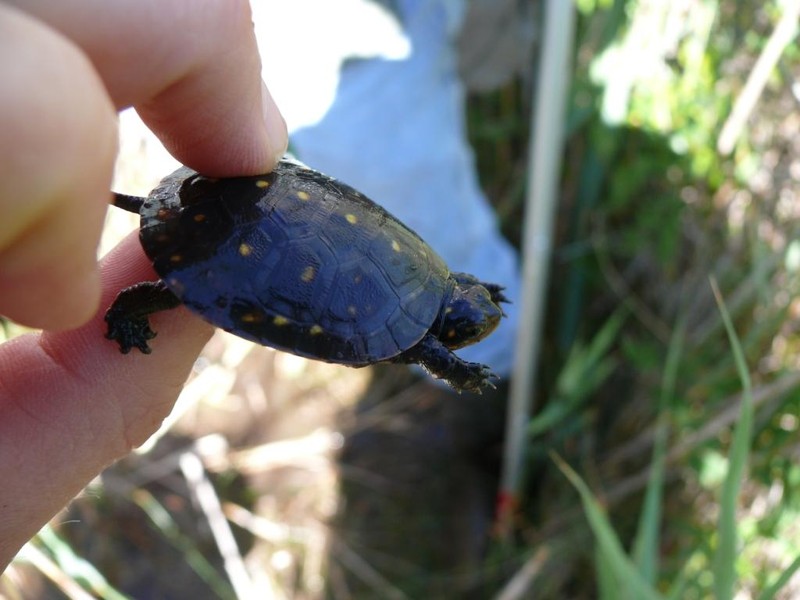Spotted Turtle
Clemmys guttata (Schneider, 1792)
- Class
- Chelonia (Turtles)
- Family
- Emydidae (Box Turtles and Pond Turtles)
- State Protection
- Special Concern
Listed as Special Concern by New York State: at risk of becoming Threatened; not listed as Endangered or Threatened, but concern exists for its continued welfare in New York; NYS DEC may promulgate regulations as to the taking, importation, transportation, or possession as it deems necessary.
- Federal Protection
- Not Listed
- State Conservation Status Rank
- S3
Vulnerable in New York - Vulnerable to disappearing from New York due to rarity or other factors (but not currently imperiled); typically 21 to 80 populations or locations in New York, few individuals, restricted range, few remaining acres (or miles of stream), and/or recent and widespread declines.
- Global Conservation Status Rank
- G5
Secure globally - Common in the world; widespread and abundant (but may be rare in some parts of its range).
Summary
Did you know?
The yellow spotted pattern on the spotted turtle’s carapace may resemble floating duckweed, which could reduce the turtle’s likelihood of being captured by a predator when in certain habitats.
State Ranking Justification
Spotted turtles appear to be widespread throughout the southern portion of the state and are most common in the Hudson Valley counties, but there has probably been less searching done in other parts of the state. Populations have been declining throughout their range in New York due to threats such as pet trade collection, pollution, and habitat destruction (NYSDEC 2019).
Short-term Trends
Spotted turtle population trends have not been well documented. However, they were once considered common in the northeast and appear to have declined throughout its range, presumably due to loss of habitat as well as declining water quality and collection for the pet trade (Milam and Melvin 2001, Natureserve 2018, NYSDEC 2019).
Long-term Trends
Spotted turtle populations seem to have declined since the early 1900s when it was reported to be common (NYSDEC 2019).
Conservation and Management
Threats
Spotted turtles face many threats. Their wetland habitats are threatened by invasive species, encroachment and development, particularly wet meadows which are not often identified as wetlands and fens which may be small and not regulated. They are also threatened by collection for the pet trade, and road mortality from crossing roads, especially in searching for nesting locations and suitable upland summer habitat (Ernst and Lovich 2009). Gibbs and Shriver (2002) found that terrestrial and semiterrestrial turtles, such as Clemmys, are impacted by habitat fragmentation from roads and that roads are a potential contributor to population decline in the northeastern United States. Spotted turtles are also negatively affected by wetland draining and an increase in predator populations, such as crows, raccoons, and coyotes (Gibbs et al. 2007).
Conservation Strategies and Management Practices
Water and habitat quality in suitable wetland complexes should be managed by avoiding the use of chemicals in and near seasonal wetlands, excluding all vehicle traffic from wetlands, and removing or controlling invasive species and woody plant encroachment (Mitchell et al. 2006). Land managers should also minimize altering wetland habitat by avoiding filling, draining, ditching or damming wetlands or doing activities that lead to excessive groundwater withdrawal in or around wetlands. Protect small wetlands and groups of wetlands, as well as the terrestrial habitats surrounding and connecting them (Joyal et al. 2001). The creation of safe travel passages underneath roads and railroad tracks would reduce vehicle mortality (Ernst and Lovich 2009). Kaye et al. (2005) found that spotted turtles in Massachusetts used a box culvert to move between the sides of a wetland that was recently bisected by a highway relocation. The 6 foot by 6 foot culvert was found to be an effective means of allowing the turtles to continue their normal movements between habitats after the road was constructed. Creation and enhancement of natural and artificial nesting sites may increase spotted turtle nesting success and reduce road mortality of gravid females (Beaudry 2010).
Research Needs
Research and monitoring to determine population trends, as well as life history and habitat use of spotted turtles in New York, is necessary. It may also be desirable to get information on the number of individuals in some sites so that some of the best occurrences can be identified. Monitoring of habitat and water quality in areas with known populations would be helpful (NYSDEC 2019).
Habitat
Habitat
Spotted turtles generally require clear, clean water with a soft substrate and aquatic or emergent vegetation (Ernst and Lovich 2009). In New York, habitat usage tends to vary seasonally. Vernal pools and small permanent pools are often used in the spring, although other habitats such as marshes, fens, and open early successional wetlands may also be used (Chaloux et al. 2010). Upland forests may be used during dormancy in parts of the summer and for travel between wetlands (Gibbs et al. 2007, Joyal et al. 2001). Spring wetlands used most frequently in Maine were characterized by abundant wood frog (Lithobates sylvaticus) egg masses and high tree cover, while forested wetlands were avoided (Beaudry et al. 2009). Females may travel up to several hundred yards to find a nesting site in early June. Nests are dug in sunny locations in grass or sedge tussocks, sphagnum moss, or loamy soils (Gibbs et al. 2007). Beaudry et al. (2010) and Joyal et al. (2001) found that in Maine spotted turtles may be more likely to nest in anthropogenic sites, such as backyards and agricultural fields.When temperatures get too high, spotted turtles may estivate in the bottom of pools of running water or within muskrat burrows, or they may move to uplands where they burrow into the ground or under vegetation (Ernst and Lovich 2009, Joyal et al. 2001 ). These turtles will overwinter in wet meadows, forested swamps, or sphagnum bogs. Spotted turtles on Long Island have also been found to use brackish water in coastal systems with emergent vegetation (Chaloux et al. 2010).
Range
New York State Distribution
Spotted turtles are found throughout the Hudson Valley, on Long Island, and in the lake plains of western and central New York. They are apparently absent from the lower southern tier counties, the Adirondacks, and the Champlain Valley. Although spotted turtles are widespread in the lake plains area, they appear to be sparsely distributed in that region.
Global Distribution
This species is found from southern Ontario and Maine south to Florida, and west to northeastern Illinois and Michigan (Ernst and Lovich 2009).
Identification Comments
General Description
This is a small turtle with a smooth, black, keelless carapace with a pattern of small, round yellow spots (Ernst and Lovich 2009). The head, upper neck, limbs, and tail are black, and often the head, neck, and limbs are spotted. The plastron is yellow or yellow-orange with a large, black spot on each scute. Older turtles and sometimes hatchlings and small juveniles may lack or lose yellow spots. Spotted turtles are sexually dimorphic. The males are smaller with longer and thicker tails, with a concave plastron, tan chin, and brown eyes. Females are larger than males, have shorter tails, and have a yellow chin, and orange eyes.
Characters Most Useful for Identification
Yellow spots on the skin and carapace.
Best Life Stage for Proper Identification
Adult and juvenile.
Behavior
Mostly diurnal, shy and easily disturbed.
Diet
Salamander and frog eggs, tadpoles, snails, slugs, spiders, worms, small crustaceans, aquatic insects (Gibbs et al. 2007, NYSDEC 2019)
Best Time to See
Sunny spring days.
- Present
- Active
- Reproducing
The time of year you would expect to find Spotted Turtle present, active, and reproducing in New York.
Similar Species
- Blanding's Turtle (Emydoidea blandingii)
(guide)
Blanding’s turtles have a hinged plastron, and a yellow chin and throat.
- Bog Turtle (Glyptemys muhlenbergii)
(guide)
Bog turtles have no spots, a keeled carapace, and a large, orange blotch on each side of the head.
Spotted Turtle Images
Taxonomy
Spotted Turtle
Clemmys guttata (Schneider, 1792)
- Kingdom Animalia
- Phylum Craniata
- Class Chelonia
(Turtles)
- Order Testudines
(Turtles)
- Family Emydidae (Box Turtles and Pond Turtles)
- Order Testudines
(Turtles)
- Class Chelonia
(Turtles)
- Phylum Craniata
Additional Resources
References
Beaudry, Frederic, Phillip G. deMaynadier, and Malcolm L. Hunter Jr. 2009. Seasonally dynamic habitat use by spotted (Clemmys guttata) and Blanding's turtles (Emydoidea blandingii) in Maine. Journal of Herpetology 43:636-645.
Beaudry, Frederic, Phillip G. deMaynadier, and Malcolm L. Hunter Jr. 2010. Nesting movements and the use of anthropogenic nesting sites by spotted turtles (Clemmys guttata) and Blanding's turtles (Emydoidea blandingii). Herpetological Conservation and Biology 5(1): 1-8.
Chaloux, A.M., J.W. Jaycox, J.D. Corser, M.D. Schlesinger, H.Y. Shaw, and E.M. Spencer. 2010. Surveying for New York's high-priority reptiles and amphibians: implications for standardized protocols. Final report. New York Natural Heritage Program. New York State Department of Environmental Conservation. Albany, NY. 2 volumes. 261 pp. plus appendices.
Ernst. C. H., and J. E. Lovich. 2009. Turtles of the United States and Canada. Second edition, revised and updated. Johns Hopkins University Press, Baltimore, Maryland. xii + 827 pp.
Gibbs, J.P., A.R. Breisch, P.K. Ducey, G. Johnson, J.L. Behler, and R.C. Bothner. 2007. The amphibians and reptiles of New York State. Oxford University Press, NY.
Gibbs, James P. and W. Gregory Shriver. 2002. Estimating the effects of road mortality on turtle populations. Conservation Biology. Volume 16, No. 6 (December 2002), pp 1647-1652.
Joyal, Lisa A., Mark McCollough, and Malcolm L. Hunter Jr. 2001. Landscape ecology approaches to wetlands species conservation: A case study of two turtle species in souther Maine. Conservation Biology. 15(6): 1755-1762.
Kaye, Delia R.J., Kevin M. Walsh, Eric L. Rulison, and Christopher C. Ross. 2005. Spotted Turtle Use of a Culvert under Relocated Route 44 in Carver, Massachusetts. IN: Proceedings of the 2005 International Conference on Ecology and Transportation, Eds. Irwin CL, Garrett P, McDermott KP. Center for Transportation and the Environment, North Carolina State University, Raleigh, NC: pp. 426-432.
Milam, J. C., and S. M. Melvin. 2001. Density, habitat use, movements, and conservation of spotted turtles (Clemmys guttata) in Massachusetts. Journal of Herpetology 35:418-427.
Mitchell, J.C., A.R. Breisch, and K.A. Buhlmann. 2006. Habitat management guidelines for amphibians and reptiles of the northeastern United States. Partners in Amphibian and Reptile Conservation, Technical Publication HMG-3, Montgomery, Alabama. 108 pp.
NatureServe. 2017. NatureServe Explorer: An online encyclopedia of life [web application]. Version 7.1. NatureServe, Arlington, Virginia. Available http://www.natureserve.org/explorer. (Accessed: February 13, 2019).
New York Natural Heritage Program. 2024. New York Natural Heritage Program Databases. Albany, NY.
New York State Department of Environmental Conservation. 2019. Spotted turtle fact sheet. Available https://www.dec.ny.gov/animals/7150.html. (Data accessed February 2019).
Links
About This Guide
This guide was authored by: Ashley R. Ballou
Information for this guide was last updated on: March 7, 2019
Please cite this page as:
New York Natural Heritage Program. 2024.
Online Conservation Guide for
Clemmys guttata.
Available from: https://guides.nynhp.org/spotted-turtle/.
Accessed July 27, 2024.



